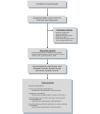Teledermatology for Enhancing Skin Cancer Diagnosis and Management: Retrospective Chart Review
- PMID: 37632911
- PMCID: PMC10335328
- DOI: 10.2196/45430
Teledermatology for Enhancing Skin Cancer Diagnosis and Management: Retrospective Chart Review
Abstract
Background: Skin cancer rates are at all-time highs, but the shortage of dermatologists compels patients to seek medical advice from general practitioners. A new referral pathway called the Suspected Skin Cancer (SSC) service was established to provide general practitioners in Waikato, New Zealand, with rapid diagnosis and treatment advice for lesions suspicious for skin cancer.
Objective: The aim of this study was to assess the quantity, quality, and characteristics of referrals to the SSC teledermatology service during its first 6 months.
Methods: A retrospective chart review of all referrals sent to the SSC teledermatology service during the first 6 months of its operation was conducted. Time to advice, diagnoses, diagnostic discordance, adherence to advice, and time to treatment were recorded. Diagnostic discordance between general practitioners, dermatologists, and pathologists was calculated.
Results: The SSC service received 340 referrals for 402 lesions. Dermatologists diagnosed 256 (63.7%) of these lesions as benign; 56 (13.9%) were histologically confirmed as malignant, including 19 (4.7%) melanomas. The overall discordance between referrer and dermatologist on specific and broad (ie, benign or malignant) diagnoses for 402 lesions was 47% and 26% (κ=0.58, SD 0.07), respectively; 44% and 26% (κ=0.61, SD 0.15) between referrer and pathologist; and 18% and 12% (κ=0.82, SD 0.12) between dermatologist and pathologist. The mean time between referral submission and receiving advice was 1.02 days. The average time to action (eg, excision) was 64.8 days.
Conclusions: An electronic referral system can be an effective form of teledermatology for providing prompt diagnosis and management advice for benign and malignant skin lesions.
Keywords: BCC; SCC; basal cell carcinoma; dermoscopy; diagnosis; keratinocyte cancer; management; melanoma; referral and consultation; skin cancer; skin lesion; squamous cell carcinoma; teledermatology; telemedicine; treatment.
©Julia L Gao, Amanda Oakley. Originally published in JMIR Dermatology (http://derma.jmir.org), 29.05.2023.
Conflict of interest statement
Conflicts of Interest: None declared.
Similar articles
-
Remote Skin Cancer Diagnosis: Adding Images to Electronic Referrals Is More Efficient Than Wait-Listing for a Nurse-Led Imaging Clinic.Cancers (Basel). 2021 Nov 20;13(22):5828. doi: 10.3390/cancers13225828. Cancers (Basel). 2021. PMID: 34830982 Free PMC article.
-
Excision pathways for keratinocyte cancers diagnosed by teledermatology: a retrospective review.J Prim Health Care. 2024 Mar;16(1):90-95. doi: 10.1071/HC23098. J Prim Health Care. 2024. PMID: 38546776
-
The Use of Teledermatology for Skin Cancer Referrals: A Retrospective Study in a Single Tertiary Centre.Cureus. 2024 Aug 31;16(8):e68284. doi: 10.7759/cureus.68284. eCollection 2024 Aug. Cureus. 2024. PMID: 39350799 Free PMC article.
-
Store-and-Forward Teledermatology for Assessing Skin Cancer in 2023: Literature Review.JMIR Dermatol. 2023 May 17;6:e43395. doi: 10.2196/43395. JMIR Dermatol. 2023. PMID: 37632914 Free PMC article. Review.
-
Teledermatology.G Ital Dermatol Venereol. 2008 Jun;143(3):213-8. G Ital Dermatol Venereol. 2008. PMID: 18833064 Review.
References
-
- Sneyd MJ, Cox B. A comparison of trends in melanoma mortality in New Zealand and Australia: the two countries with the highest melanoma incidence and mortality in the world. BMC Cancer. 2013 Aug 06;13(1):372. doi: 10.1186/1471-2407-13-372. https://bmccancer.biomedcentral.com/articles/10.1186/1471-2407-13-372 1471-2407-13-372 - DOI - DOI - PMC - PubMed
-
- Dermatology Workforce Service Forecast. studylib.net. [2023-04-25]. https://studylib.net/doc/7049517/dermatology-workforce-service-forecast... .
-
- Oakley AM, Astwood DR, Loane M, Duffill MB, Rademaker M, Wootton R. Diagnostic accuracy of teledermatology: results of a preliminary study in New Zealand. N Z Med J. 1997 Feb 28;110(1038):51–3. - PubMed
LinkOut - more resources
Full Text Sources
Research Materials


